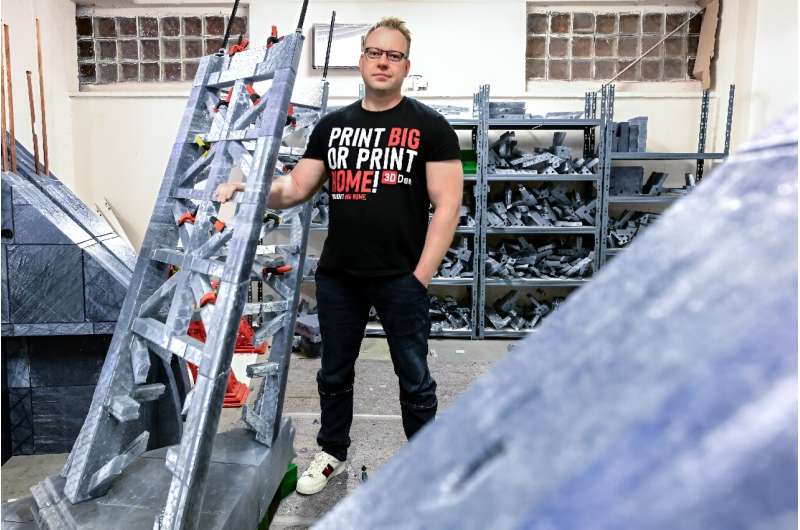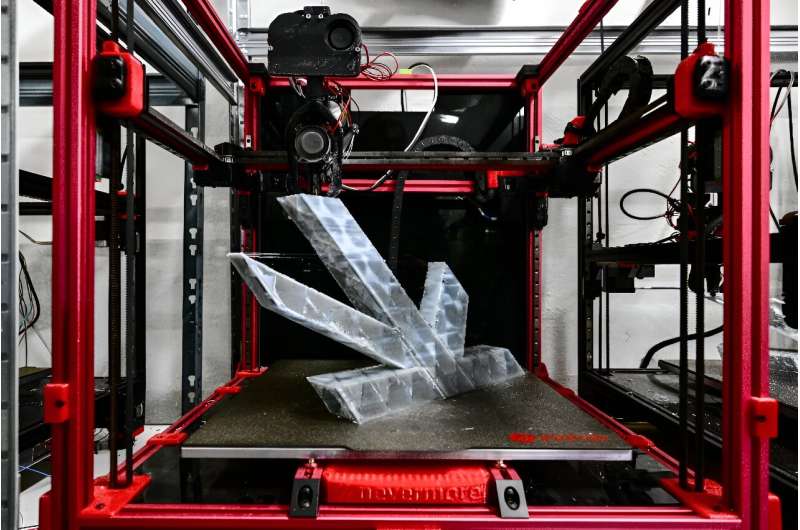This article has been reviewed according to Science X's editorial process and policies. Editors have highlighted the following attributes while ensuring the content's credibility:
fact-checked
reputable news agency
proofread
Czechs 3D-print Eiffel Tower from ocean waste for Olympics

A Czech company is 3D-printing a giant Eiffel Tower model for a local Olympics event, using recycled ocean waste as the primary material.
The 14-meter-high (46-foot) model will be installed at an Olympic festival in the north of the Czech Republic, where the public can try different Olympic sports during the Paris Games in July and August.
Jan Hrebabecky, the owner of the 3DDen printing farm, uses printing filament made from ocean waste.
"The material for the Eiffel Tower comes from the shores of Thailand," he told AFP.
"It has excellent mechanic and chemical qualities, great UV resistance, and it is practically immortal."
Collected by Thai fishermen, the plastic waste is sorted, cleaned, desalinated and dried.
A Swiss company turns the waste into granules which a Czech company then processes into 3D-printing filaments.
Hrebabecky had to build a new printer to cope with the material.

"It can crystallize in the printer and destroy it immediately," Hrebabecky said.
But advantages prevail, including the price which is lower than that of traditional filaments.
"There are huge deposits of this priceless material, and anybody can come and take it," said Hrebabecky.
Plastic Eiffel Tower
With more than 200 printers, his company has so far printed key rings, miniature sculptures, medals and USB keys.
"But my goal is to print really large things, so we're making furniture and interior decorations as well," Hrebabecky said.
His printers are now busy with the Eiffel Tower, a puzzle of 1,600 3D-printed pieces fortified with steel rods, which Hrebabecky says will be solid enough to hold a helicopter.
He said the two-tonne structure, made from material equivalent to 800,000 plastic bottles, would stand next to the Most lake in northern Czech Republic, which will host the Olympic festival on July 26-August 11.
Nada Cerna, a Czech Olympic Committee manager in charge of the event, said it would allow people to try 52 Olympic sports, watch the Games on large screens and meet Czech athletes in person.
She told AFP 3DDen had impressed the organizers with its environmental-friendly approach.
"It's very important for us. Oceans are a place where people do sports like sailing and windsurfing," she said.
"So if we can highlight the problem in this way and maybe help a bit, we're really happy," Cerna added.
For Hrebabecky, the Eiffel Tower is a step towards a dream he wants to accomplish soon—a printed house.
"If you build a house using this material, it is almost certain that it will never return to the ocean again," he said.
© 2024 AFP





















